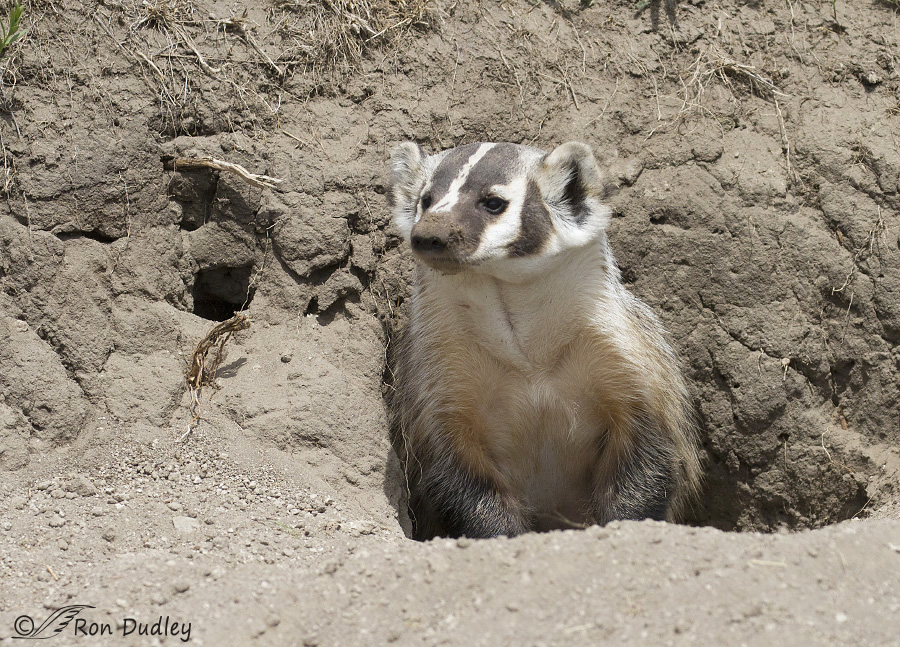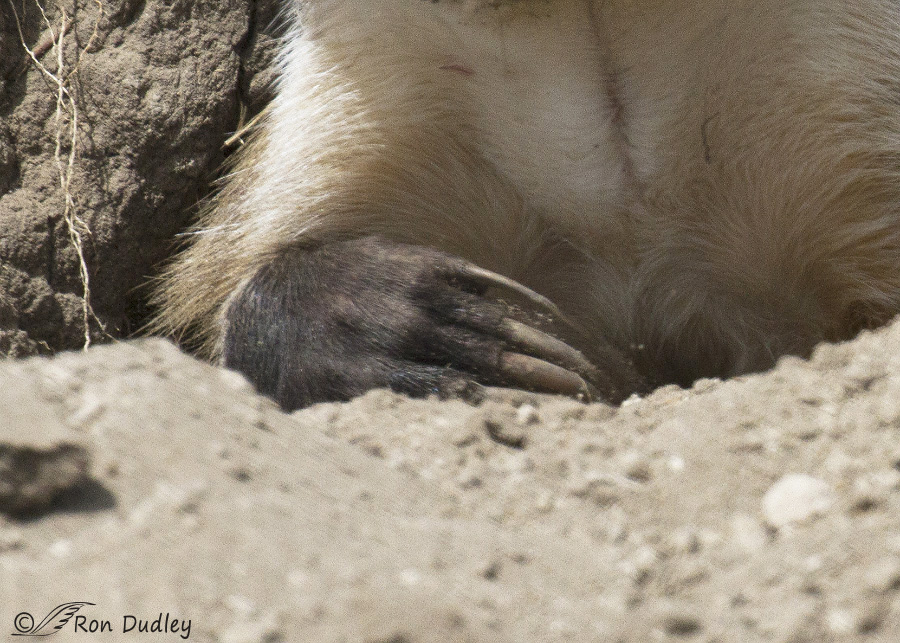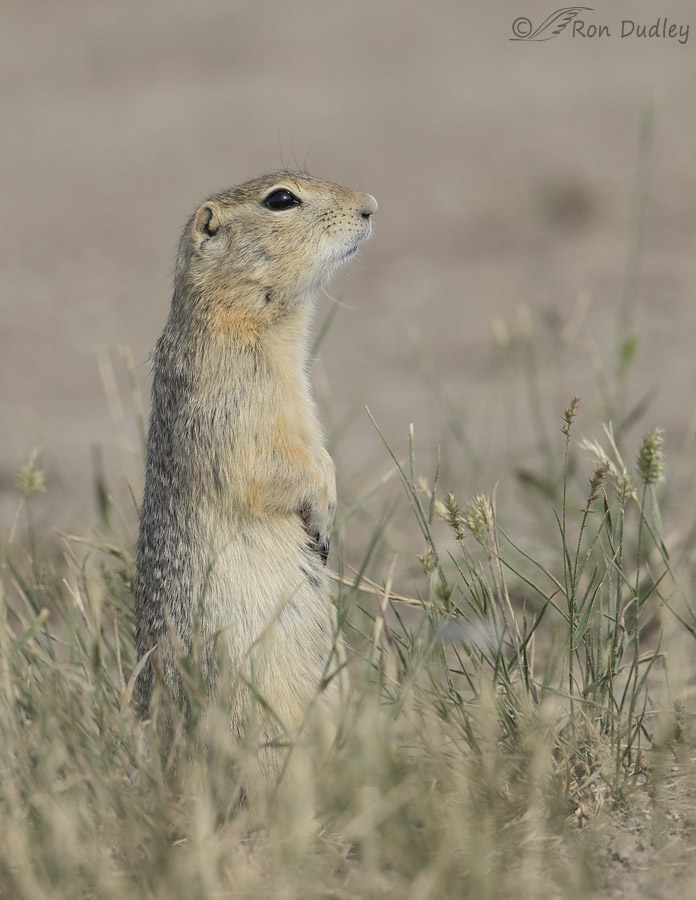An American Badger here in Utah buried an entire cow carcass and they have it on “video” – (really time lapse photography, speeded up). It was only a calf but it’s still hugely impressive and the behavior was previously unknown. And they have evidence of it having been done another time too. They suspect it happens regularly and we just didn’t know about the behavior.
I photographed this badger in June of last year near the Montana/Idaho border. Just look at that muscleman chest and those incredibly powerful “forearms” designed for digging. Their digging skills are legendary. My Audubon Field Guide To Mammals says that badgers are such formidable diggers that if someone tries to dig one out of its burrow they can “outpace a man with a shovel, showering dirt in the face of its attacker”.
This is the business end of those powerful digging front legs – long, semi-curved claws that can dig quickly in hard packed soil.
A few days ago time-lapse photography by a Utah conservation biologist was released that documents a badger burying a young cow. Badgers are known to bury food but have never been documented burying anything larger than themselves. The clip is definitely worth watching and I’d recommend it be seen full screen. Here’s a link to the time-lapse photos on National Geographic – “Badger Buries Entire Cow Carcass“.
Richardson’s Ground Squirrel (“gopher”)
All this brought back one of my memories of growing up on the Montana farm but telling the story requires a confession on my part. As kids my cousin Ken Dudley and I used to shoot “gophers” (Richardson’s Ground Squirrels). Gophers raise havoc on grain farms in the spring by eating the new wheat and barley shoots to the point that entire fields can be laid bare. And their holes are hard on farm equipment. I’ve shot many thousands of gophers in my day – it was part of growing up in rural Montana and still is. I’m not defending the practice – it is what it is.
The next morning Ken and I occasionally noticed that a particular gopher we’d shot was gone – all that remained was a small area of freshly churned earth where the gopher had been. Some missing gophers of course would be scavenged by predators (raptors, badgers etc) but what would explain the churned earth where some of the gophers had been? Back then we never figured it out.
Ken stayed on the farm after I left for Utah to become a teacher and many decades later I received an excited phone call from him – he’d solved the mystery. One late evening he’d watched as Burying Beetles were in the process of burying one of the gophers he’d shot. The next morning the gopher was gone, leaving behind only freshly churned earth. Both of us were excited to finally know the answer to the long-standing mystery.
These days Burying Beetles in many areas are threatened or endangered and they have completely disappeared from large parts of their original range.
Anyway, this “new” badger behavior reminded me of those beetles so I decided to share the story.
Ron





Beautiful photos of both the Badger & Gopher, thank you for sharing!
Wonderful series and interesting info Ron!
Charlotte
Busy as a beaver needs to be reworked. Busy as a badger works for me.
How fascinating.
I wonder whether all badgers will tackle such hugs jobs or whether this one is particularly entrepeneurial….
I wondered the same thing, EC. I’m sure “they’ll” be doing more intense research on exactly that now that the behavior has been documented.
And here I expected an April Fool’s entry but the video you linked to is dated March 31. Fascinating!
Linda, I wondered if some might think that. Nope, this is real.
Fascinating articles! I had no idea that a badger could bury something so large, nor that there are beetle species of which both parents care for and feed their young in much the same way as birds.
My only critique is in the choice of the “doo-d’doo” music; I would have selected a more dirge-like accompaniment to a burial scene. 😉
Thanks so much for sharing such cooleriferous info, Teech! 😀
Marty, I didn’t know about the beetles either, until Ken sleuthed out the answer. And I’m the biologist! Agree about the music.
Watched video…very interesting…couldn’t believe how fast that badger worked!!! Literally zoomed around!!!
Patty, Keep in mind that “video” was really time lapse photography, speeded up.
🙂
REALLY???????!!!!!!
Another great educational post! Thank you. I’m sorry to hear about the plight of the Burying Beetles. These days, loving and learning about wildlife and wild places is always tinged with more than a bit of worry and sadness.
Thanks, Joanne. I hope our little experiment regarding your comments having to be approved works so it now longer has to be done!
Elephant’s Child had to go through the same process.
Is it true that Antelope Island is being closed for “six months to a year to allow for wildlife restoration and regeneration ” and will only be open to bicycles and personnel during that time? Our Turkish friend ,Yadloof Lirpa, from Sandy, emailed us this info this morning…
That should read ” Yadsloof Lirpa” …probably doesnt make any difference unless you read it backwards….
Patty, No – that report is bunk. Damn good thing too!
Happy April Fools Day…or Yadsloof Lirpa!!!
Hook, line and sinker. Even after the “backward” hint…
Live and learn! Very educational, never would have known that Badgers buried their food. Would have thought that decay would set in before the animal had a chance to finish it off. Burying Beetles, yes and I have actually (some time ago, 1970s) seen them in action.
Many thanks for the lesson.
“never would have known that Badgers buried their food”
They also bury their own feces, Dick. Interesting critters.
Once a teacher, always a teacher! From a fellow teacher, -Joel
You’ve got that right, Joel!
Very interesting information…We (my mother) shot woodchucks (groundhogs)because they destroyed our kitchen garden…Later, as a adult myself, woodchucks were among those I rehabbed…..Badgers are amazing creatures…never heard of them burying something as large as a calf, but with those huge digger paws and ferocious attitudes, they could probably bury a tractor!!! Occassionally you’d hear of a tractor being “stolen”, now I can’t help but wonder…..
Thank you, Patty.
WOW! Quite a feat and stash for the badger! 🙂 Shooting “gophers” was a right of passage growing up here in North Central Montana – first “real game” for many a young hunter. 🙂 The beetles disposing of “gopher” remains is interesting. I too would have just figured coyotes/hawks etc. were doing it! GREAT education this morning! 🙂 Thx, Ron
“Shooting “gophers” was a right of passage growing up here in North Central Montana”
It was exactly that in northern MT too, Judy. Still is I believe.